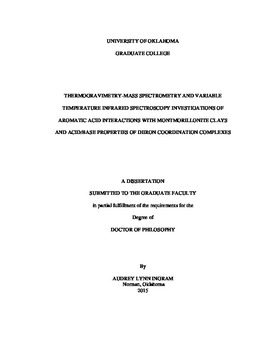| dc.contributor.advisor | White, Robert | |
| dc.contributor.author | Ingram, Audrey | |
| dc.date.accessioned | 2015-12-17T19:41:36Z | |
| dc.date.available | 2015-12-17T19:41:36Z | |
| dc.date.issued | 2015-12 | |
| dc.identifier.uri | https://hdl.handle.net/11244/23311 | |
| dc.description.abstract | Thermogravimetry-Mass Spectrometry (TG-MS) and Variable-Temperature Diffuse Reflection Infrared Fourier Transform Spectroscopy (VT-DRIFTS) were used to investigate interactions of benzoic acid, salicylic acid, and acetylsalicylic acid with potassium, sodium, and calcium montmorillonite clays. The presence of adsorbates perturbed the environments of interlayer water molecules. Below 60 oC, heating adsorbate/clay samples resulted in changes to both the adsorbate and water molecule local environments. Results described here show that TG-MS m/z 18 ion signal temperature profiles can be employed to selectively monitor water molecule desorption, which can provide information regarding thermal stabilities of interlayer water molecule environments. VT-DRIFTS measurements below 60 oC also provided selective tracking of sample changes associated with water loss. Absorbance band changes that occur in the O-H stretching vibration regions of infrared spectra reflected local environment changes to adsorbate and inorganic oxide hydroxyl groups and to interlayer water molecules. VT-DRIFTS C=O stretching and O-H bending vibration band changes are more dramatic and provide greater selectivity with respect to the nature of adsorbate molecule environment changes. Dehydration by heating samples from ambient temperature to 60 oC resulted in complex changes to adsorbate acid group environments that depended on the structure of the adsorbate and the clay interlayer cation. Above 60 °C, TG-MS results for samples containing acetylsalicylic acid indicated that it decomposed by reaction with water to form salicylic acid and acetic acid. Salicylic acid also decomposed, but at higher temperatures than acetylsalicylic acid, producing phenol and carbon dioxide. Results obtained at higher sample temperatures provided information regarding adsorbate interactions with dehydrated environments as well as measures of relative adsorbate stabilities. Studies described here provide detailed characterizations of adsorbate environments within clay substrates and how these environments change as a result of dehydration.
Additionally, the acid-base properties of [(FeL)2(µ-OH)]BPh4, [(FeL)2(µ-O)], and [FeLCl] (where L = the dianion of 2,2'-(2-Methyl-2-(pyridin-2-yl)-propane-1,3-diyl)bis(azanediyl)-bis(methylene)diphenol) were characterized in acetonitrile. [(FeL)2(µ-OH)]BPh4 was reversibly deprotonated by strong bases such as 1,8-Diazabicyclo[5.4.0]undec-7-ene (DBU). [(FeL)2(µ-O)] was titrated with benzoic acid under inert conditions, and the pKa of the hydroxo bridge in [(FeL)2(µ-OH)]+ was estimated to be 20.4, which is remarkably high compared to literature reports for other hydroxo-bridged diiron complexes. | en_US |
| dc.language | en_US | en_US |
| dc.subject | Infrared spectroscopy, thermogravimetry-mass spectrometry, montmorillonite clays | en_US |
| dc.title | Thermogravimetry-Mass Spectrometry and Variable Temperature Infrared Spectroscopy Investigations of Aromatic Acid Interactions with Montmorillonite Clays and Acid/Base Properties of Diiron Coordination Complexes | en_US |
| dc.contributor.committeeMember | Nanny, Mark | |
| dc.contributor.committeeMember | Nicholas, Kenneth | |
| dc.contributor.committeeMember | Yip, Wai Tak | |
| dc.contributor.committeeMember | Yang, Zhibo | |
| dc.date.manuscript | 2015-12-17 | |
| dc.thesis.degree | Ph.D. | en_US |
| ou.group | College of Arts and Sciences::Department of Chemistry and Biochemistry | en_US |
| shareok.nativefileaccess | restricted | en_US |
